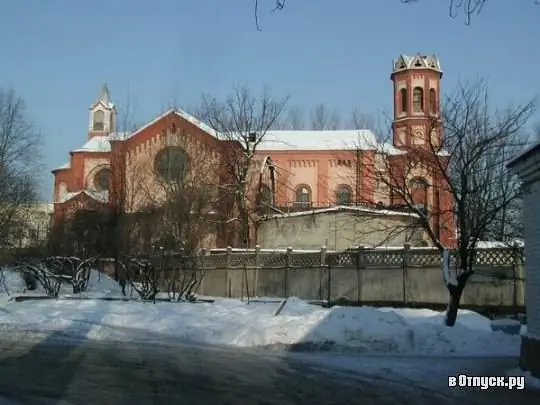
Description of the attraction
Even at the beginning of the reign of Alexander II, the authorities of St. Petersburg allowed the establishment of a Roman Catholic cemetery with a chapel in the city, for which state land on the Vyborg side, also called the Kulikovo field, was allocated. The project of the chapel was carried out by the famous architect of the highest court N. L. Benoit.
The temple was founded on July 2, 1856, and the committee for the construction of the chapel and the arrangement of the cemetery was headed by Father Domenik Lukashevich, prior of the Cathedral of St. Catherine on Nevsky Prospekt. Already in 1859, a new church was consecrated in the name of the Visit of the Blessed Virgin Mary Elizabeth by Metropolitan V. Zhilinsky.
The remains of Archbishop I. Golovinsky, who died in 1855, were buried in the church underground. Later, other clergymen were buried there. In addition, the tombs of the Counts Pototskikh and the Benois family were built in the temple, and in 1898 the body of the architect of the church, Nikolai Benois, was buried here. The gravestones of the Catholic hierarchs were made of marble and depicted the dead lying in full growth, dressed in ceremonial clothes with a miter on their heads.
The chapel was a basilical structure in the shape of a Latin cross, installed on the base of a crypt-basement. The transverse transept of the inner space and the longitudinal nave were overlapped by the cross vaults. There were no high-rise details, the only exception was the cross at the intersection of the gable roofs. The decoration of the chapel was a promising shallow portal of the western entrance, with a stained glass rose located above it and narrow windows along the perimeter of the chapel under the arcature belt of the cornice. For about twenty years, the chapel looked like this.
In 1877, a wealthy Polish parish decided to give the chapel the status of a temple. Designed by N. L. Benois, an octahedral bell tower with a ringing tier was attached to the building, as well as a high tent, which was crowned with a Catholic cross. Thanks to the reconstruction, the chapel building has acquired eclectic forms. The painting of the temple was made by the artist Adolphe Charlemagne. The re-consecration of the church took place in 1879. It began to bear the name of the Visit of the Most Holy Virgin Mary Elizabeth. It received the status of a parish church in 1902. In the same year, Fr. Anthony Maletsky, two oak altars were made according to the project of Stanislav Volotsky.
Since 1912, burials in the cemetery have been limited. And in 1918. Archbishop von Ropp, fearing the nationalization of the cemetery, ordered the closure of the cemetery. But, despite his efforts, in 1920. the cemetery was nationalized. Many monuments were destroyed and graves were polluted. However, in the period from 1918 to 1933. The school at the cemetery church, founded by the sisters of the community of Blessed Boleslava Lament, continued to operate underground. Lessons were often held even in the gravestone chapels. In addition, a monumental workshop, a parish house, a nursing home, a school, and a nursery orphanage were built at the church.
In 1923, a fire destroyed almost all of the interior decoration of the church. The church continued to function until November 1938, despite the fact that part of the cemetery had already been destroyed at that time, it housed an iron foundry. In 1939 the Krasnogvardeisky District Council made a decision on the final liquidation of the old Vyborg cemetery, which was destroyed in the period from 1939. until 1949 the Temple was finally closed, the parish was liquidated. The building first stored potatoes, and then rebuilt for industrial use, completely destroying the bell spire. Until our time, the building housed the laboratory of the Agrophysical Institute.
Since 1991, the Roman Catholic Church began to fight for the return of the building, and in 1992. the parish was officially registered. On May 31, 2005, the building of the Church of the Visitation of the Blessed Virgin Mary Elizabeth was returned to the Catholic Church. Mass is now held here.
The building of the temple is included in the Unified State Register of Historical and Cultural Monuments of the Peoples of the Russian Federation as an object of cultural heritage of regional importance.






